Shear Wave Velocity Determination of a Complex Field Site Using Improved Nondestructive SASW Testing
Abstract
:1. Introduction
2. Traditional SASW Testing
2.1. Traditional SASW Field Testing Procedure
2.2. Development of the Vs Profile
- = Frequency;
- = Wavelength;
- = Receiver Spacing;
- = Unwrapped Phase Angle.

3. Improved SASW Testing
3.1. Benefit of Improved SASW Field Testing
3.2. Validation of Improved SASW Field Testing through Case Study
4. Discussion and Conclusions
- (1)
- Additional testing in the reverse direction enabled not only deeper profiles on both sides of the array but also increased data reliabilities and resolution due to extra overlapping data. In practice, performing additional tests in the opposite direction requires about 25–30% extra time and effort but provides the advantage of obtaining twice as much data;
- (2)
- Another benefit of additional testing in the opposite direction includes the availability of checking the SASW data during collection. If a difference in data with the same spacing is found during a test, the test procedure can be adjusted to improve the quality of the site characterization. In practice, the quality improvement of data collected during the field test results in a significant improvement in the accuracy of data analysis;
- (3)
- The testing and data-analysis procedures of the improved SASW method were explained by showing a dataset from a real, laterally variable field site. Two main differences were found in this real dataset. First, the left side of the centerline showed higher Vs values in the bedrock. Second, the depth of the bedrock on the left side of the centerline is shallower than the right side. The original geologic information was used to validate these two differences found from the SASW test. Based on the investigation, these two lateral differences exist at the site. It would not be possible to see the differences between the two sides from the centerline if traditional SASW was performed.
Author Contributions
Funding
Institutional Review Board Statement
Data Availability Statement
Acknowledgments
Conflicts of Interest
References
- Nazarian, S.; Stokoe, K.H. In situ Shear Wave Velocities from Spectral Analysis of Surface Waves. In Proceedings of the 8th World Conference on Earthquake Engineering, San Francisco, CA, USA, 21–28 July 1984; Prentice-Hall: San Francisco, CA, USA, 1984; pp. 31–38. [Google Scholar]
- Stokoe, K.H.; Nazarian, S. Measurement and use of shear wave velocity for evaluating dynamic soil properties. In Use of Rayleigh waves in liquefaction Studies; Woods, R.D., Ed.; ASCE: New York, NY, USA, 1985; Volume 3, pp. 154–196. [Google Scholar]
- Joh, S.H. Advances in the Data Interpretation Technique for Spectral-Analysis-of-Surface-Waves (SASW) Measurements. Ph.D. Thesis, The University of Texas at Austin, Austin, TX, USA, 1996; 240p. [Google Scholar]
- Rix, G.J.; Lai, C.G.; Foti, S.; Zywicki, D. Surface Wave Tests in Landfills and Embankments. ASCE Geotech. Spec. Publ. 1998, 75, 1008–1019. [Google Scholar]
- Haegeman, W.; Van Impe, W.F. Characterization of Disposal Sites from Surface Wave Measurements. J. Environ. Eng. Geophys. 1999, 4, 27–33. [Google Scholar] [CrossRef]
- Stokoe, K.H.; Hwang, S.; Joh, S.H. Spectral Analysis of Surface Waves (SASW) Testing to Evaluate Vs Profiles at Geotechnical and Geological Sites. In Proceedings of the 16th World Conference on Earthquake Engineering, Santiago, Chile, 9–13 January 2017. Paper No. 494. [Google Scholar]
- Cho, Y.S. NDT response of spectral analysis of surface wave method to multi-layer thin high-strength concrete structures. Ultrasonics 2002, 40, 227–230. [Google Scholar] [CrossRef] [PubMed]
- Kim, D.S.; Shin, M.K.; Park, H.C. Evaluation of Density in Layer Compaction Using SASW Method. Soil Dyn. Earthq. Eng. 2001, 2, 39–46. [Google Scholar] [CrossRef]
- Kim, G. Evaluation of Ground Compaction Using SASW Testing. J. Korean Geosynth. Soc. 2023, 22, 9–15. [Google Scholar]
- Martínez-Soto, F.; Ávila, F.; Puertas, E.; Gallego, R. Spectral analysis of surface waves for non-destructive evaluation of historic masonry buildings. J. Cult. Herit. 2021, 52, 31–37. [Google Scholar] [CrossRef]
- Albatal, A.H.; Mohammad, H.; Elrazik, M.A. Effect of inadequate site investigation on the cost and time of a construction project. In Geotechnical Safety and Risk IV; Taylor & Francis Group: Abingdon, UK, 2014. [Google Scholar]
- Arshid, M.U.; Kamal, M.A. Regional Geotechnical Mapping Employing Kriging on Electronic Geodatabase. Appl. Sci. 2020, 10, 7625. [Google Scholar] [CrossRef]
- Biernacik, P.; Kazimierski, W.; Włodarczyk-Sielicka, M. Comparative Analysis of Selected Geostatistical Methods for Bottom Surface Modeling. Sensors 2023, 23, 3941. [Google Scholar] [CrossRef] [PubMed]
- Liu, J.; Liu, J.; Li, Z.; Hou, X.; Dai, G. Estimating CPT Parameters at Unsampled Locations Based on Kriging Interpolation Method. Appl. Sci. 2021, 11, 11264. [Google Scholar] [CrossRef]
- Kim, H.-S.; Sun, C.-G.; Kim, M.; Cho, H.-I.; Lee, M.-G. GIS-Based Optimum Geospatial Characterization for Seismic Site Effect Assessment in an Inland Urban Area, South Korea. Appl. Sci. 2020, 10, 7443. [Google Scholar] [CrossRef]
- Crisp, M.P.; Jaksa, M.; Kuo, Y. Optimal Testing Locations in Geotechnical Site Investigations through the Application of a Genetic Algorithm. Geosciences 2020, 10, 265. [Google Scholar] [CrossRef]
- Li, X.; Lu, X.; Li, M.; Hao, J.; Xu, Y. Numerical Study on Evaluating the Concrete-Bedrock Interface Condition for Hydraulic Tunnel Linings Using the SASW Method. Appl. Sci. 2018, 8, 2428. [Google Scholar] [CrossRef]
- Schevenels, M.; Lombaert, G.; Degrande, G.; François, S. A probabilistic assessment of resolution in the SASW test and its impact on the prediction of ground vibrations. Geophys. J. Int. 2008, 172, 262–275. [Google Scholar] [CrossRef]
- Kim, G.; Hwang, S.; Stokoe, K.H. Evaluation of Lateral Variability in Vs Profiles at Geotechnical Sites using the Improved Spectral-Analysis-of-Surface-Waves (SASW) Method. In Proceedings of the 12th National Conference on Earthquake Engineering, Salt Lake City, UT, USA, 27 June–1 July 2022. Paper No. 10181. [Google Scholar]
- Stokoe, K.H.; Cox, B.; Clayton, P.; Menq, F. NHERI@UTEXAS Experimental Facility: Large-scale Mobile Shakers for Natural-hazards Field Studies. In Proceedings of the 16th World Conference on Earthquake Engineering, Santiago, Chile, 9–13 January 2017. Paper No. 2387. [Google Scholar]
- Lin, C.P.; Lin, C.H.; Chien, C.J. Dispersion Analysis of Surface Wave Testing–SASW vs. MASW. J. Appl. Geophys. 2017, 143, 223–230. [Google Scholar] [CrossRef]
- Roslan, M.; Madun, A.; Zainalabidin, M.H.; Dan@Azlan, M.F.M.; Abu Talib, M.K.; Zahari, M.N.H.; Ambak, K.; Ismail, M.A.M. Soil Compaction Assessment Using Spectral Analysis of Surface Waves (SASW). J. Phys. Conf. Ser. 2018, 995, 012119. [Google Scholar] [CrossRef]
- Lin, Y.C.; Joh, S.H.; Stokoe, K.H. Analysis of the UTexas 1 Surface Wave Dataset Using the SASW Methodology; ASCE, Geo-Congress: Atlanta, GA, USA, 2014; Technical Papers, GSP 234. [Google Scholar]
- Joh, S.H.; Kang, T.H.; Kwon, S.A.; Won, M.C. Accelerated Stiffness Profiling of Aggregate Bases and Subgrades for Quality Assessment of Field Compaction. J. Transp. Res. Board 2006, 1975, 63–72. [Google Scholar] [CrossRef]
- Foinquinos, M.R. Analytical Study of Inversion for the Spectral Analysis of Surface Waves Method. Master’s Thesis, The University of Texas at Austin, Austin, TX, USA, 1981; 119p. [Google Scholar]
- Kausel, E.; Roesset, J.M. Stiffness Matrices for Layered Soils. Bull. Seism. Soc. Am. 1981, 71, 1743–1761. [Google Scholar] [CrossRef]
- Mitu, S.M.; Rahman, N.A.; Nayan, K.A.M.; Zulkifley, M.A.; Rosyidi, S.A.P. Implementation of Machine Learning Algorithms in Spectral Analysis of Surface Waves (SASW) Inversion. Appl. Sci. 2021, 11, 2557. [Google Scholar] [CrossRef]
- Joh, S.-H.; Vivar, J.A.; Akmal, H. Wavenumber Unwrapping for the Automated Analysis of SASW Measurements. Soil Dyn. Earthq. Eng. 2023, 167, 107795. [Google Scholar] [CrossRef]
- Maraveas, C.; Bartzanas, T. Sensors for Structural Health Monitoring of Agricultural Structures. Sensors 2021, 21, 314. [Google Scholar] [CrossRef] [PubMed]



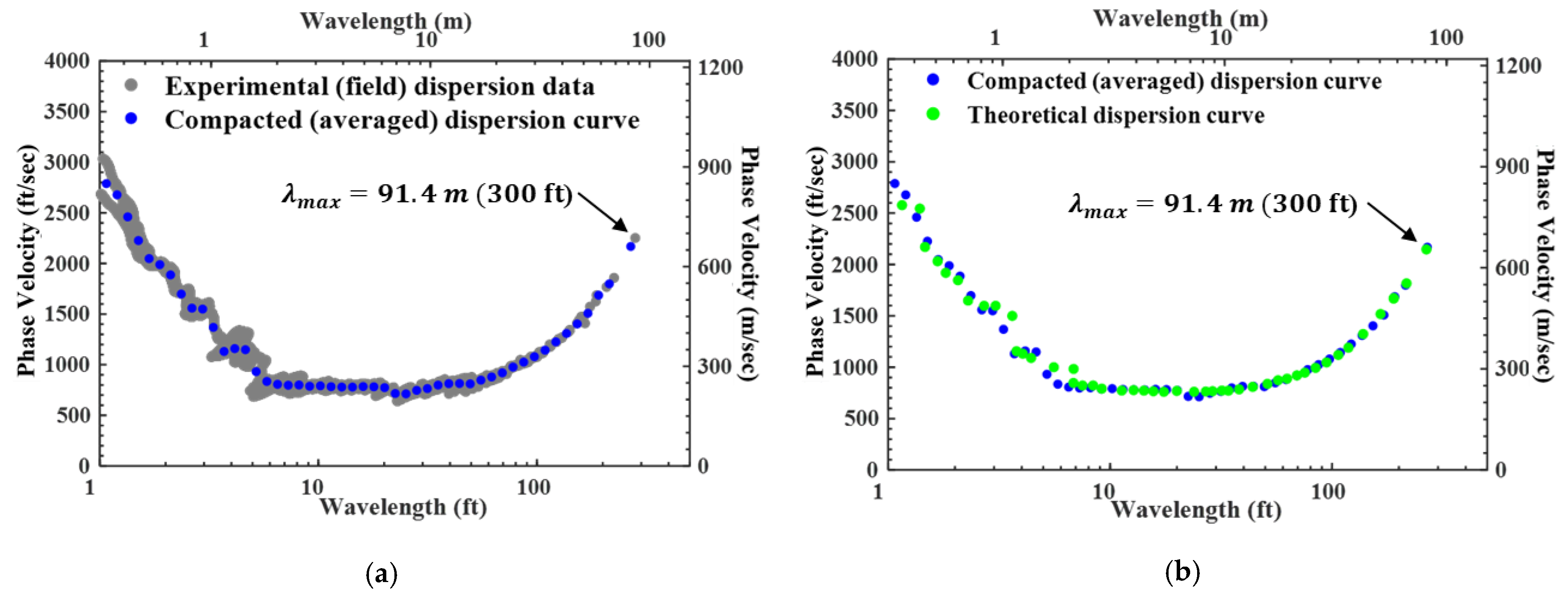
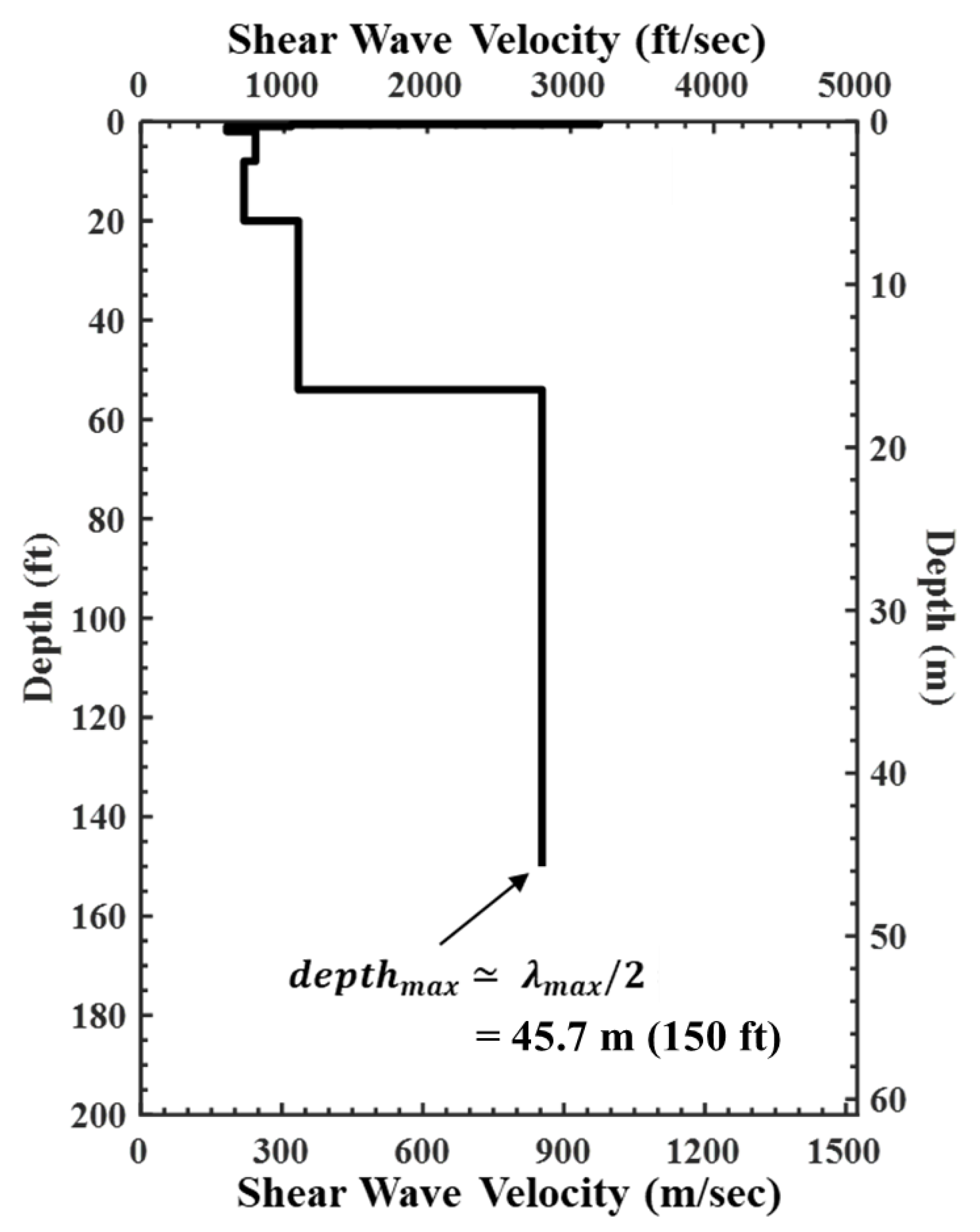
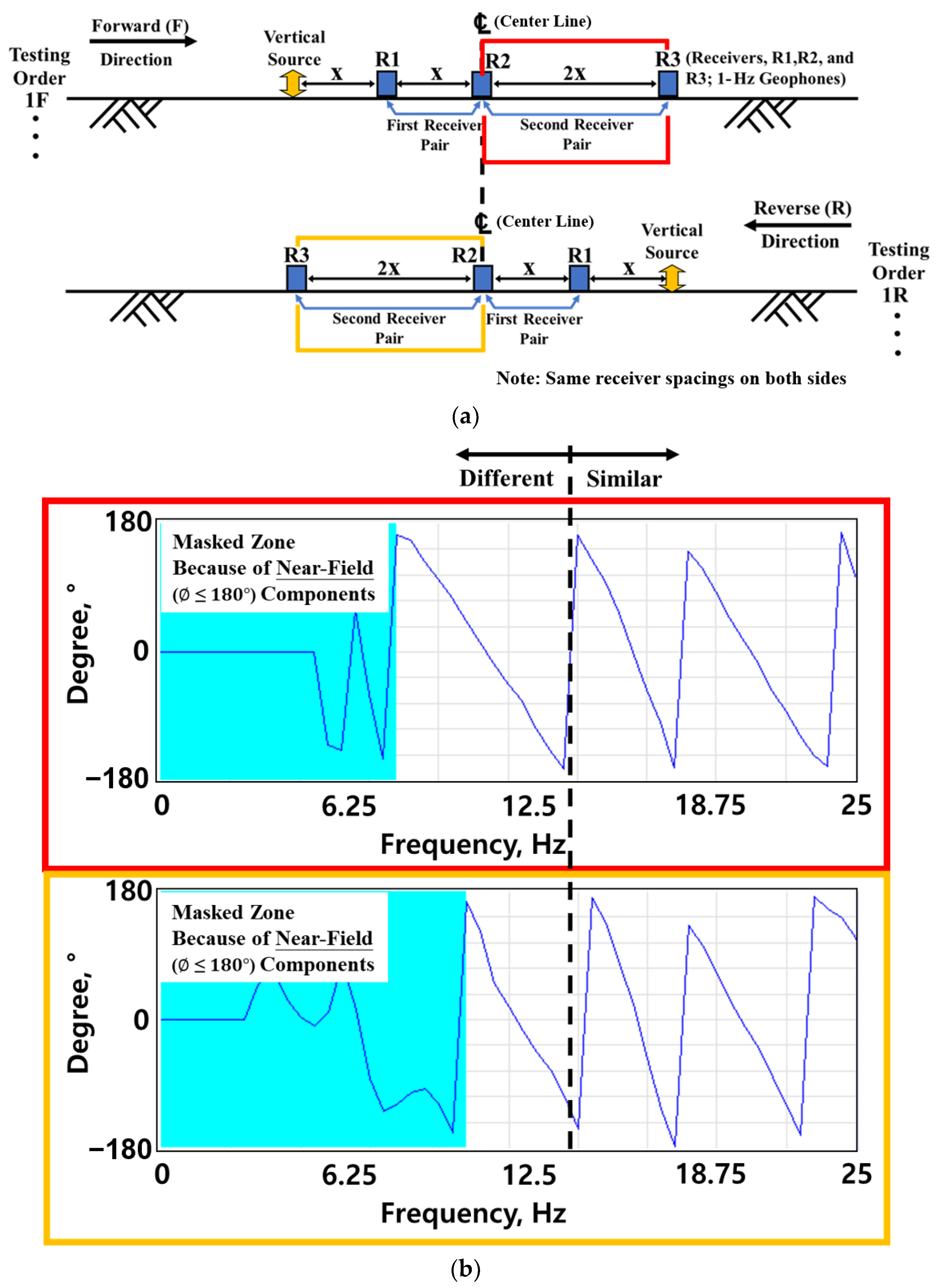
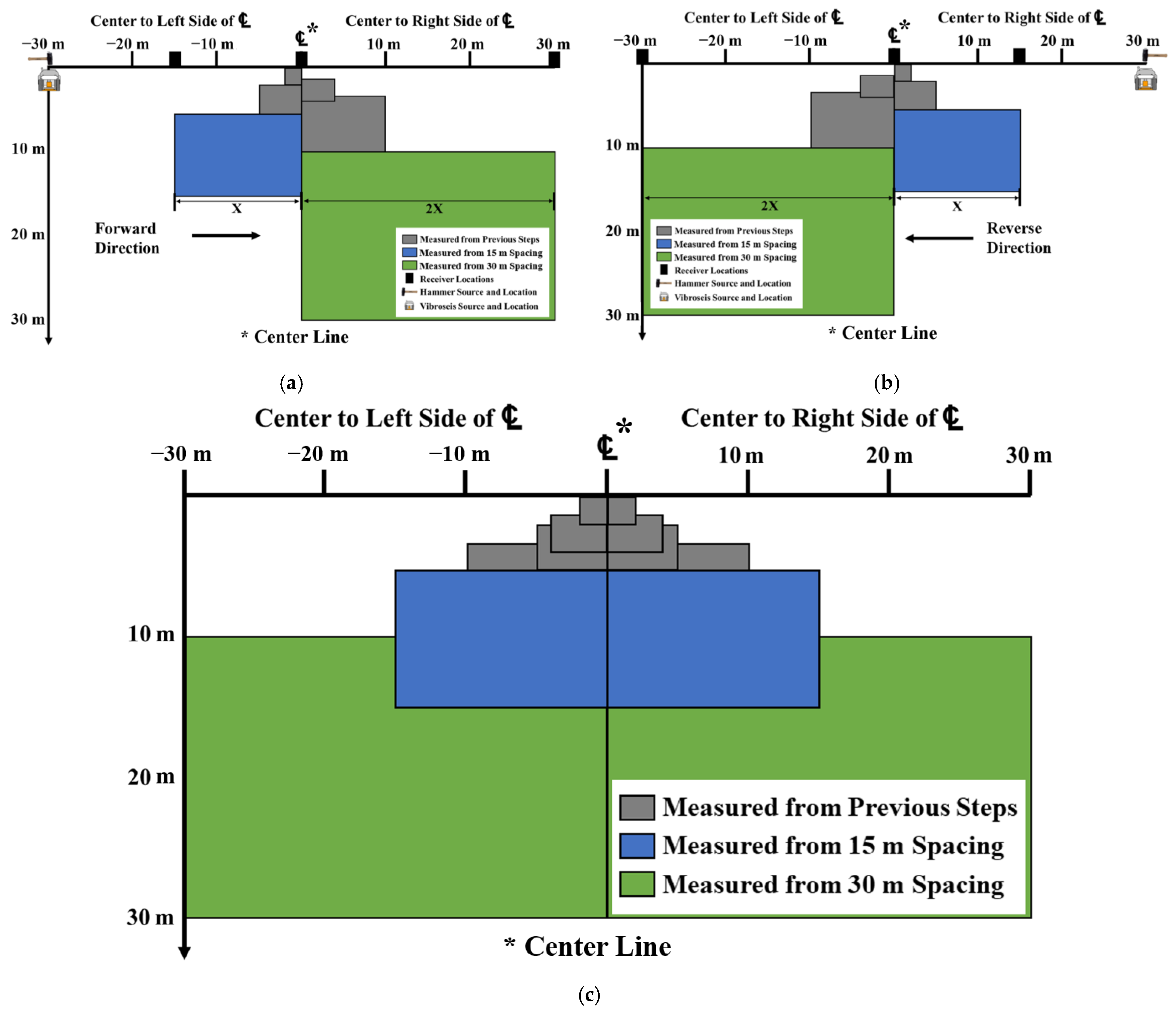
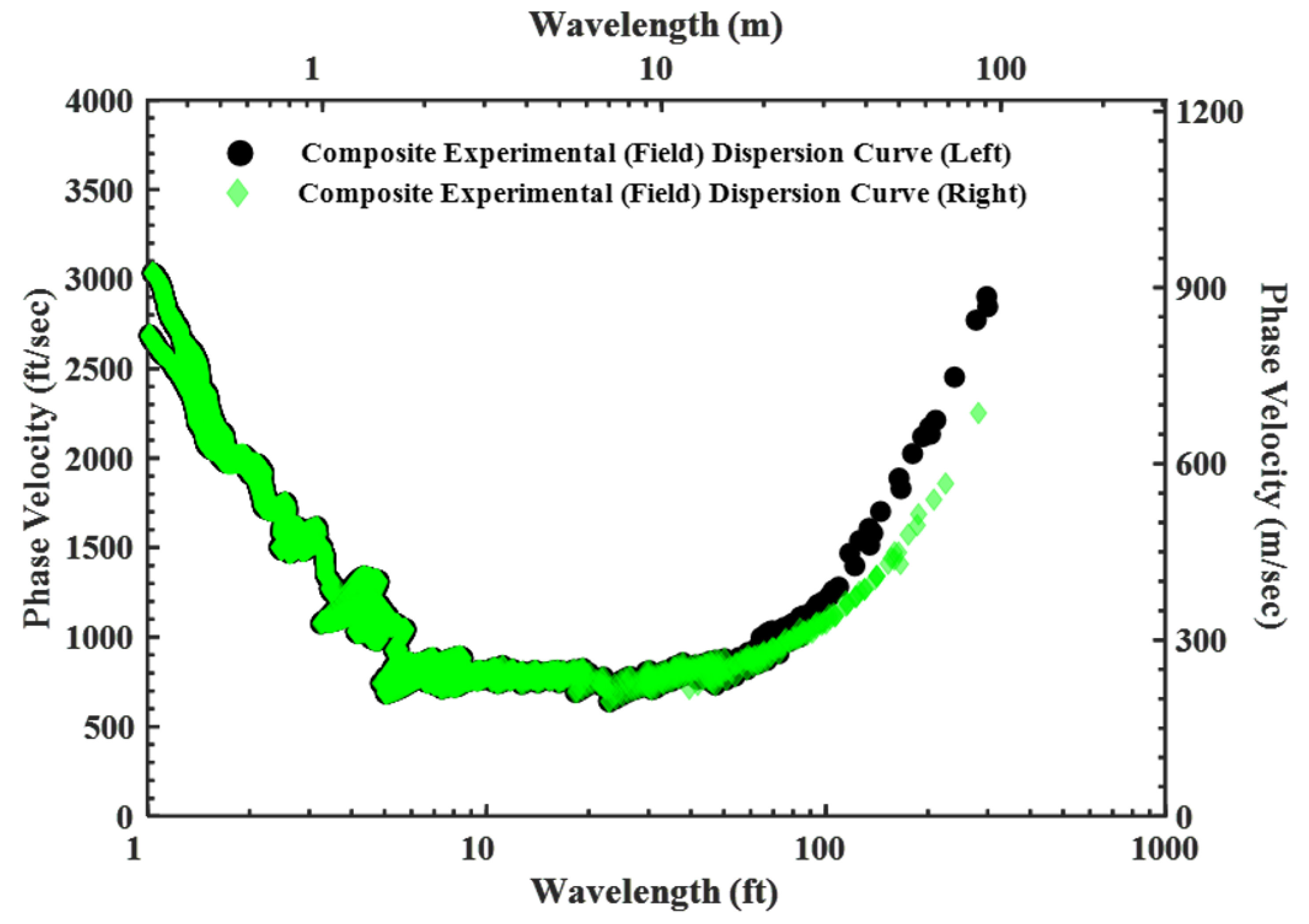

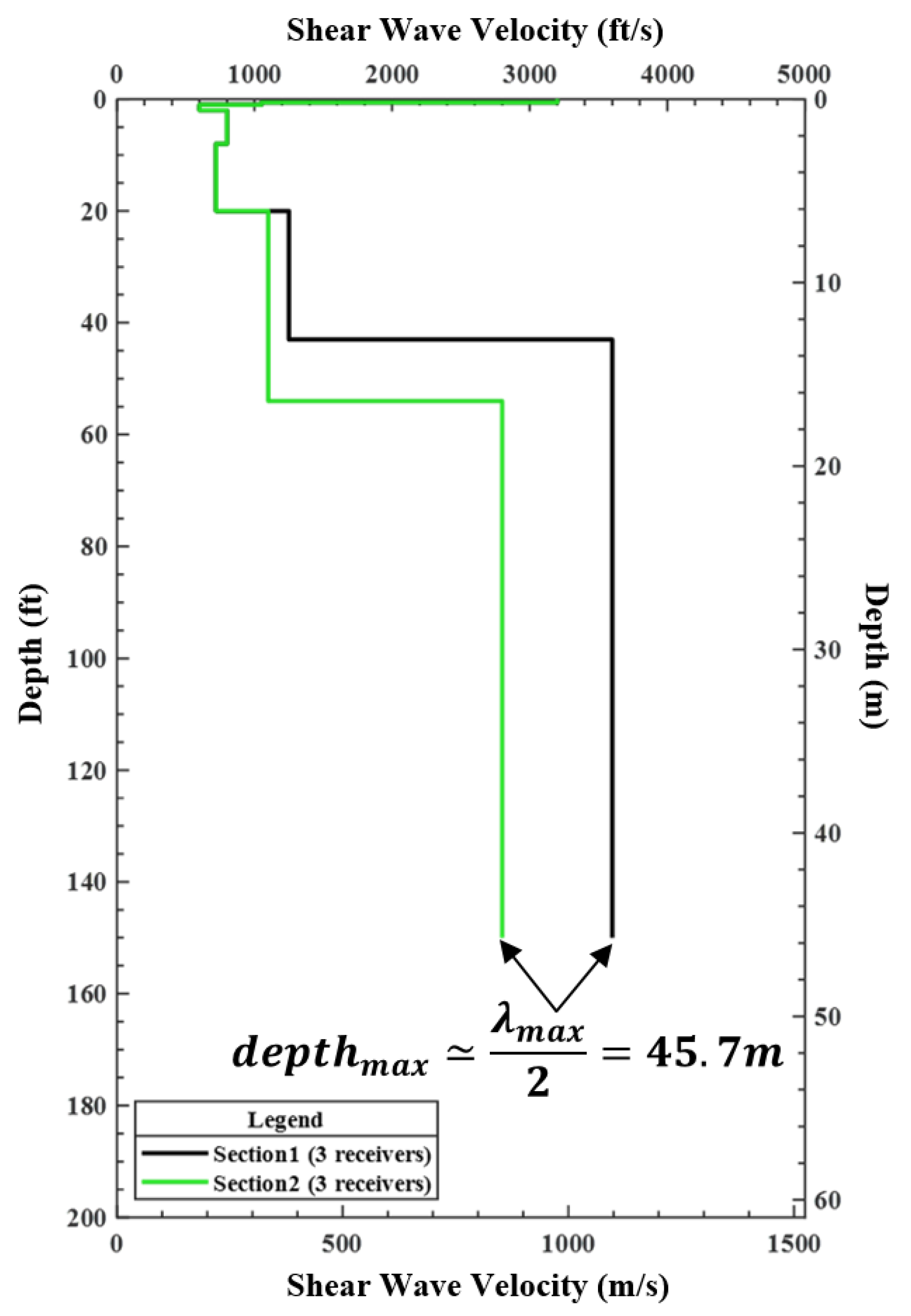
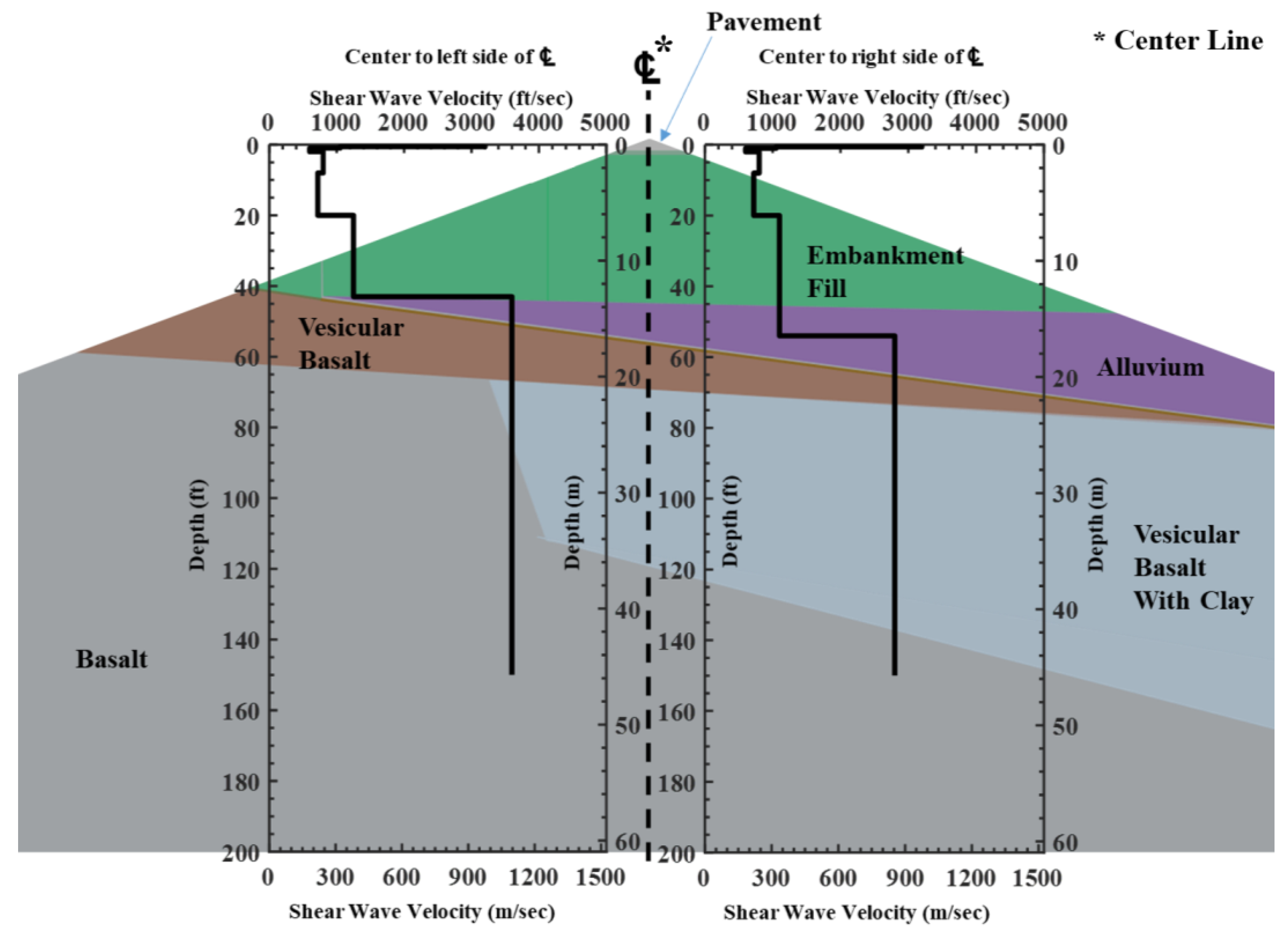
| Material Type (Depth Range) | This Site (Left Side) | This Site (Right Side) | Site 1 (Dam) | Site 2 (Field Site) | Site 3 (Field Site) |
|---|---|---|---|---|---|
| Embankment Fill (1~40 ft) (0.3~12 m) | 750~1250 ft/s (229~381 m/s) | 750~1100 ft/s (229~335 m/s) | 800~1300 ft/s (244~396 m/s) | - | - |
| Alluvium (40~60 ft) (12~18 m) | - | 1100 ft/s (335 ms) | 1000~1600 ft/s (305~488 m/s) | - | - |
| Vesicular, Aphanitic, and Hard Basalt (50~150 ft) (15~46 m) | 3600 ft/s (1097 m/s) | - | 2900~3500 ft/s (884~1067 m/s) | - | 3000~4000 ft/s (914~1219 m/s) |
| Basalt with sediment (Silt, Clay) (50~150 ft) (15~46 m) | - | 2800 ft/s (853 m/s) | - | 2600~2800 ft/s (792~853 m/s) | - |
Disclaimer/Publisher’s Note: The statements, opinions and data contained in all publications are solely those of the individual author(s) and contributor(s) and not of MDPI and/or the editor(s). MDPI and/or the editor(s) disclaim responsibility for any injury to people or property resulting from any ideas, methods, instructions or products referred to in the content. |
© 2024 by the authors. Licensee MDPI, Basel, Switzerland. This article is an open access article distributed under the terms and conditions of the Creative Commons Attribution (CC BY) license (https://creativecommons.org/licenses/by/4.0/).
Share and Cite
Kim, G.; Hwang, S. Shear Wave Velocity Determination of a Complex Field Site Using Improved Nondestructive SASW Testing. Sensors 2024, 24, 3231. https://doi.org/10.3390/s24103231
Kim G, Hwang S. Shear Wave Velocity Determination of a Complex Field Site Using Improved Nondestructive SASW Testing. Sensors. 2024; 24(10):3231. https://doi.org/10.3390/s24103231
Chicago/Turabian StyleKim, Gunwoong, and Sungmoon Hwang. 2024. "Shear Wave Velocity Determination of a Complex Field Site Using Improved Nondestructive SASW Testing" Sensors 24, no. 10: 3231. https://doi.org/10.3390/s24103231
APA StyleKim, G., & Hwang, S. (2024). Shear Wave Velocity Determination of a Complex Field Site Using Improved Nondestructive SASW Testing. Sensors, 24(10), 3231. https://doi.org/10.3390/s24103231






